BY ANN FARMER
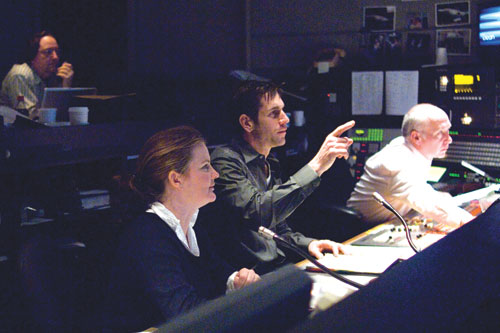 TAKE ONE: Director and Executive Producer Frank Valentini (pointing)
TAKE ONE: Director and Executive Producer Frank Valentini (pointing)
assisted by Associate Director Mary Ryan. (Photo: Steve Fen/ABC)It's Monday afternoon, and on ABC's daytime soap opera One Life to Live, the young, blonde and beautiful Sarah Roberts has just discovered hunky Todd Manning lying comatose in a bed, blood from a chest wound oozing through the sheet. Peering down at Todd, Sarah hears him faintly murmur the name of his ex-wife, "Blair." She rummages in a drawer, pulls out Todd's cellphone and hurriedly scrolls down to that listing. Then she hesitates. She stares into space. An anxious expression ripples across her countenance.
"Cut," says director and executive producer Frank Valentini into his control room headphone, bringing the scene to a pause. "Tell her to look more nervous," he relays to his stage manager, Alan Needleman, who receives the instruction through his earpiece while standing on the alert in the studio. The production is taking place in a cavernous armory on the Upper West Side of Manhattan that ABC took over decades ago. Needleman immediately walks up to the actress playing Sarah and whispers in her ear. She nods and repositions herself along with the crew. The next take works like a charm.
"This is where the stage manager is of the utmost importance," explains Needleman as the shooting resumes. "You are the eyes and ears of the director when he or she is in the control room. You are funneling a lot of information from the director and it's coming out of your mouth."
Without the stage manager's help, in fact, the directors on One Life to Live would never be able to churn out scene after scene, episode after episode, year after year of this longstanding, award-winning show. The same thing applies to the other members of the directing team: The three associate directors ready the cameras and edit the show. The two production associates track all the details and monitor the show's running time.
"It's a completely interdependent world," says director Larry Carpenter, emphasizing that each directing team role is vital in facilitating the director's vision. "It's the director's energy that drives the day," Carpenter says. "But without the team it'd be insane. I depend on every DGA person there to help me accomplish the direction of the show."
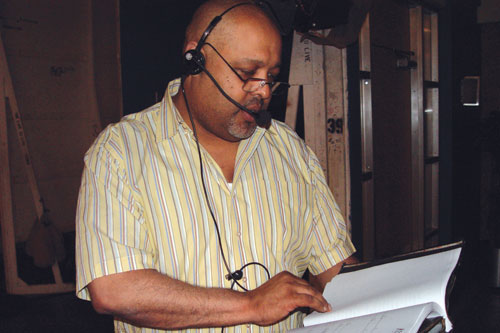 ON THE FLY: Stage Manager Keith Greer keeps his eye on the script.
ON THE FLY: Stage Manager Keith Greer keeps his eye on the script.
(Photo: Todd Garrin/ABC Photos)
Compared to nighttime episodic dramatic television, in which an entire week is set aside to produce a one-hour episode, daytime soaps are produced at an average of six one-hour shows a week. "Our day is very high-paced," explains producer John Tumino, who's usually found in the back row of the control room, giving the final approval on each scene.
After the 7:30 a.m. rehearsal, dozens of cameras, boom operators, stagehands, hair and makeup artists begin circling the talent. Some directors plow through as many as 140 pages a day. After the studio finally shuts down, anytime from 7 p.m. to midnight, the carpenters and electricians begin tearing down the sets and reconstructing tomorrow's. The lighting crew arrives in the middle of the night to start hanging lights for the next day's shoot.
"Because we have to keep things moving and on budget," adds Tumino, "it all happens at incredible speed. What it comes down to is: time is money."
At the same time, One Life's high production values remain a hallmark of the show. The soap is noted for staging fantastic events that have included tornadoes, a prison breakout, and a plane crash for which they cut and hauled a DC-3 from Tucson to their Manhattan studio and partially rebuilt it. This year, the show was nominated for 10 Daytime Emmys, including one for the directing team. Jill Mitwell, one of the seven directors on the show, and her team also won the 2006 DGA Award for Outstanding Directorial Achievement in Daytime Serials.
When asked how the DGA crew keeps the operation moving, Valentini says, "You want someone who thinks before you do," describing how every single detail must be considered and put down on paper before anyone walks into the studio. And that preparation, more or less, begins with the production associates.
Nathalie Rodriguez started as a script supervisor and a year ago became a production associate. "This job is good because you learn every aspect of production," she says, as she sits in her office upstairs from the set. She's meticulously reviewing a director's script that's marked with meeting notes for a shoot that will take place in two weeks.
"We go through it page by page," Rodriguez says, describing how she's looking for cue times and notes about special effects, sound or props. For instance, a scene might require a meal that needs to be arranged for. Or perhaps a clock needs to be set at an exact hour and minute. "We try to foresee problems before they happen.
She draws up a formal prop list and a schedule for the actors' hair and makeup calls. "We're the liaison between everybody and the director," she says, just as her phone rings. It's already past 4 p.m., but someone wants a wig that matches an actor's hair for tomorrow's shoot. "This is the type of last-minute thing that comes up," she says, dialing the prop department. "But it always ends up working out."
Moving on to her next task, she picks up a stopwatch to time the show's dialogue. The script for each episode is usually about 100 pages. It's up to the production associates to estimate whether these novellas effectively time out for the show's running time. Rodriguez's lips move silently as she reads through each scene, recording its length and circling each estimate before moving on. Since every episode also involves a range of actors, coming up with an accurate timing is tricky. "When you first start doing it, it's very hard," says Rodriguez. "But after awhile, you get to know the voices of the actors and you get a sense."
"It's half luck and half skill," adds Anthony Wilkinson, another production associate. He recalls the first time he had to estimate a lovemaking scene. Since there was no dialogue, he asked for advice. "The director said, 'Give it 30 seconds,'" Wilkinson recalls wryly. "So I allowed 30 seconds. When they did the scene it was 3-1/2 minutes long."
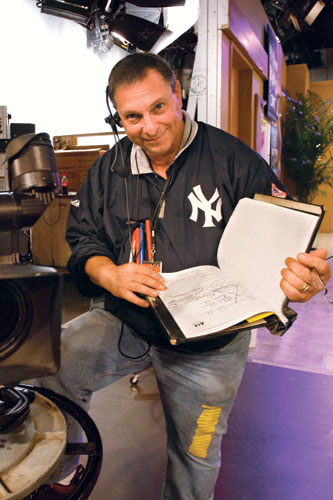 Stage Manager of 16 years Alan Needleman keeps it light on the set.
Stage Manager of 16 years Alan Needleman keeps it light on the set.Any number of factors can throw an estimate off. Actors might read their lines slower because of their mood. "Sometimes scenes go more quickly because of the excitement," says director Gary Donatelli. "One director may be a quick storyteller, whereas it takes me five minutes to say hello," he adds self-deprecatingly, while also pointing out that if a show is long, it can always get cut in the edit. If it's short, then you have a problem.
As a further safeguard, the PA will again track the show's running time on the actual shooting day. They take their spot on the front deck of the booth and record the ins and outs of each take, informing the associate director whenever anything's off, including script deviations. "The PAs are held accountable as the day proceeds," says Donatelli.
The PA also attends a morning dry rehearsal before the shooting commences, which is the first time the actors speak their lines together. He or she follows along, marking any script or shot changes, which they incorporate into a revised "cut and changes" packet and distribute. Since scenes are often shot out of sequence, the PAs must also be prepared to field continuity questions. "Sometimes a director asks us what happened before this scene to get a better sense of things," says Rodriguez.
"It's a very grueling job," admits Wilkinson, who says he regularly clocks in 60-hour weeks. He's not the only one. The stage managers step into the production process once the morning rehearsal ends around 9 a.m., and they often remain on the floor for the next 12 hours. This is when things start percolating. All the lights have been hung and the sets reconstructed. One Life has 125 sets. About four to six of them are utilized in a shooting day. As the stagehands, actors, camera operators, director and rest of the crew merge onto the set to block the first scene of the day, it's up to the stage manager to control the chaos.
"They are the bosses of the floor," says Donatelli. "They ensure that the actors are up and ready on time. They supply the carpenters, electricians, and hair and makeup. They're like field lieutenants. They keep order on the floor."
Actually, with his Bronx accent and affable manner, the lead stage manager, Alan Needleman, seems more like the mayor of the operation. He's been stage-managing One Life since 1991. For 21 years before that he worked as a production manager for ABC. He also does stand-up comedy, which serves him well in this capacity. "He knows how to quiet an entire bleacher section and get them roaring," says Donatelli. "We work long days. It's good to have someone with a sense of humor."
 Associate Director Tracy Casper Lang gets ready for a take.
Associate Director Tracy Casper Lang gets ready for a take.

Production Associate Nathalie Rodriguez clocks a show's running time.
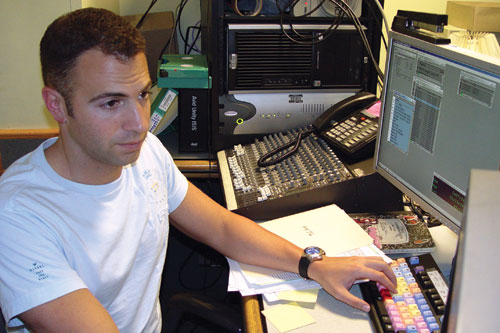
Production Associate Anthony Wilkinson regularly works 60 hour weeks.Just then, Needleman comes out with a quip. Donatelli is directing a bedroom scene and half-jokingly told the actors, "Mad, passionate love has been made, like nothing on this planet." Needleman pipes in, "You mean for three minutes, like in my house?" eliciting a chuckle from everybody.
"I try to break up the normal everyday tension," he says later. "But there is a time and place for everything. If we were shooting a serious scene, I wouldn't want to break it up with any levity."
The stage manager is also responsible for prompting and cueing the actors. That's why Needleman sticks close to the director while he blocks a scene, recording the camera shots and making diagrams in his battered, black notebook.
For instance, today one scene opens with a character lying on a prison cot with his head poking out of a body bag. Using a pen from the gaggle he keeps on a chain around his neck, Needleman draws a square that indicates the set. Inside that, he draws a stick figure with a sad expression in relation to where the actor is lying. "This is a stage manager's delight," Needleman chuckles, because most of the time he has to draw more complex scenarios, with multiple characters and various arrows indicating which direction the action moves.
"The actors will say, 'Needles, where do I cross stage right?'" says Needleman, who also keeps a column of yellow, one-inch tape strips adhered to his left pants leg for marking spots. "In my black book, I've drawn an arrow, so I know where they need to go from."
When they're in the booth, the directors also turn to the stage managers for help in guiding the emotional performance of the actors. "It's tough when [we're] in the booth and [we] want to stop and say something to the actors," says director Larry Carpenter. "I can't take the temperature of the floor, nor can I run out and take the time to give all the notes," he adds, explaining that he has to keep things moving. However, he says he's quite comfortable passing his notes via Needleman. "He is very aware of how to help an actor get the performance accomplished."
Needleman adds, "You've got to be a people person. The actors need to trust you. A lot of it is tact. I'll make a note to one actor one way and a note to another actor another way. You're dealing with a lot of egos."
What Needleman especially enjoys is choreographing the extras. "It is a lot of fun," he says, describing how he sometimes directs dozens of extras for as many as eight to 10 cameras (although, on average, scenes are shot with three or four cameras). He'll show the extras how to act in the background and to look for visual cues, such as when he raises two fingers indicating that they should move behind camera two.
When a scene is finally ready to be shot, Needleman gives the 5-4-3-2 countdown, along with the associate director in the booth. "I'll tell the AD, 'We're ready on the floor,' and they'll say, 'We're ready in here,'" explains Needleman, who stays silent on the count of one and points to whichever actor speaks first.
It's critical that the set remains quiet. That job more often falls to the second stage manager, Keith Greer. In fact, Greer barks out "quiet" so many times in a day that recently, he says, "I was in a restaurant with friends and I inadvertently shushed the whole restaurant." He laughs, "Another time, I woke myself up from sleep saying, 'Standby.'"
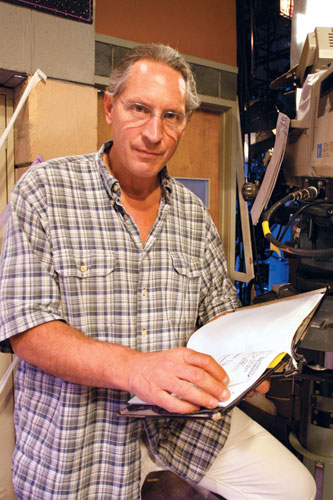 TEAMWORK: Director Gary Donatelli moves as much as 140 pages a day.
TEAMWORK: Director Gary Donatelli moves as much as 140 pages a day.Today, however, Greer has other concerns. The writers and producers have created their version of High School Musical to air June 20, showcasing the singing talent of its younger cast. This episode features an original music score woven around a prom night theme. After weeks of the preparation, everybody's hyped to shoot the first foggy, dreamlike sequences being directed by Jill Mitwell.
But right now, the fog keeps getting sucked up into the air vents almost as quickly as it's being generated. While Greer troubleshoots that problem, another ABC stage manager, Brendan Higgins, brought in just for the day, rehearses the talent—snapping his fingers to help the talent match their strides.
Meanwhile, in the control room, associate director Mary Ryan is doing her part to realize Mitwell's creative ideas. During an earlier take, Ryan noticed how an actor appeared too pensive. "He needed to do a little more with his face. Also, we had too much fog on the master," she says, explaining how she brought those issues to Mitwell's attention and they reshot the scenes. "She's open to that," says Ryan.
The associate director functions as the right arm of the director. In fact, the AD sits to the director's right in the control room on the front deck along with the PA. But what the ADs are especially good at is multitasking. They ready the cameras by constantly communicating with the camera operators. When everybody's set, they give the five-second cue. They also interact heavily with the PA, technical director and producer. "You've got to have good eye and mouth coordination," says Ryan.
Later, it's the AD who will fine-edit the show in postproduction. "That's because the pace we go at is so incredibly fast," says Carpenter. "So we have to trust the AD to take what we're doing in the booth and move it into edit, and make it be our vision."
While in the booth, the AD prepares for their subsequent edit session by taking notes and filling out a log listing which material from each camera needs to be digitized overnight for the nonlinear AVID edit system. Often in the middle of shooting, the AD may realize that a scene could look awkward the way it's being shot. "You want to make sure you have what you need," says Ryan, who brings any potential editing issues to the attention of the director and producer. They decide whether it's worth taking the time and expense to reshoot a scene differently.
To manage all these responsibilities, the three ADs on One Life rotate days in the booth, the edit room, and an online day when they assemble elements such as credits and clip reels. "We try to edit the shows we worked on," says associate director Tracy Casper Lang, as she sits in the edit chair trying to shave 30 seconds off an episode. Valentini checks on her progress and tells her, "That was better, whatever you just did," before scooting out again.
"The directors may give editing notes, but we execute what they have in mind," she continues, explaining that One Life was the first soap to use ADs as editors. She says it's excellent experience for becoming a director, something she's already doing as a backup. "When you're sitting here," says Lang, "you really see if something doesn't work."
The way things work at One Life to Live, it's quite common for the ADs, PAs and stage managers to move up the ranks. "I'm always pushing my people through," says Valentini, who started out at One Life over 20 years ago as the assistant to the executive producer, and subsequently sailed through every position on the directing team.
He adds, "Long ago, I heard that Woody Allen likes to work with the same crew because then it becomes like shorthand. That's what we've been able to do here—create a little shorthand."